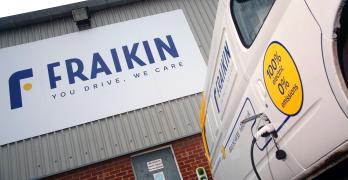Biogas: clean driving thanks to waste
- 12/01/23
- 4 min
A champion of the circular economy, biogas is produced from our waste. This free resource is an alternative fuel that brings together all of the environmental benefits. Its combustion does not emit any particles and ensures “carbon neutrality”.

The automotive industry continues to challenge itself and to pursue efforts to introduce cleaner manufacturing processes. Could alternative fuels become a key solution? This is undoubtedly the case with biomethane, which is more sustainable than fossil methane. In fact, many engines run on methane, known as NGV (Natural Gas for Vehicles). While it is usually obtained from fossil deposits, it can also be produced continuously by nature. Micro-organisms generate biogas, consisting mainly of CO2 and methane, by decomposing organic waste. This methane, biological in origin, is called biomethane. It is separated from the other components of biogas during a purification process. One molecule of fossil methane produces a greenhouse effect at least twenty times greater than one molecule of CO2. Capturing methane that comes from the natural decomposition of biomass thus provides an environmentally-friendly fuel and limits the quantity of greenhouse gas that contributes to global warming.
Driving on waste – carbon neutrality within reach
If we are to move towards carbon neutrality, the use of an alternative fuel such as biogas is one of the surest ways, especially since all fermentable waste can be used to produce it. Household waste, sewage plant sludge, agricultural or forestry waste – all of it can be converted into biogas. More broadly, all biomass – namely, all organic matter of animal or plant origin – can be used. The product of biological decomposition, biomethane has a “neutral” carbon footprint when burned.
The carbon contained in biogas was already present in living organisms on the surface of the Earth before it became a part of biogas. This carbon is then found in the CO2 emitted after the biomethane is used as a fuel. This CO2 will then be assimilated by plants through photosynthesis and reincorporated into biomass. As it is part of the “carbon cycle”, the use of biomethane as a source of fuel makes it possible to claim “CO2 neutrality”. In contrast, the use of fossil methane extracted from the ground increases the quantity of carbon on the planet’s surface, which has consequences for the climate.
Biogas is an easy-to-obtain alternative fuel that can be produced locally
Biogas is a “local” energy source, often produced and used in a local loop. It requires relatively basic facilities whose operating costs consist of input collection costs. Depending on local resources, input material is collected within a radius of 8 to 30 km of the digester. By recovering waste, which is mainly agricultural, the production of biomethane responds perfectly to the challenges of the energy transition process while developing “green growth”.
In addition to its use in the local loop, biomethane can also be injected into the distribution grid to which it is sold by the producer. In France, the first injection of biomethane into the grid was carried out in 2011; there were more than 200 injection points in 2020.
Across Europe, the development of biogas production and injection varies. It depends on government support, but also on the variability of the regulatory framework and tariff conditions. At the end of 2019, there were in Europe 18,943 biogas sites (167 TWh) and 725 biomethane sites (26 TWh). By 2030, 11% of the gas consumed in Europe could come from renewable sources (biogas and green hydrogen).
How do you run a fleet on biogas?
Like other alternative fuels, biogas is handicapped by limited distribution. Today, in comparison with electric engines, NGV vehicles are less expensive, provide a greater range and offer body-building options similar to those of diesel vehicles. In comparison with hydrogen, biogas is more accessible, more mature and already “green” due to its very nature.
Driving with locally produced biomethane is feasible for a captive fleet that operates around its depot. Sometimes a pricing structure can be introduced to go further. As the molecule of biomethane is identical to that of fossil methane, gas distributors offer a “biomethane” tariff in certain countries, including France. Higher than that of fossil methane, the tariff covers the costs of injecting biomethane and also permits the use of this virtuous fuel to be communicated. At the end of 2019, 150 of the 900 German NGV filling stations only sold bio-NGV.
CEO of the Jacky Perrenot transport group (5,500 vehicles), Philippe Givone said: “I remain a strong supporter of biomethane because it is a virtuous energy. Today, it is the one that best meets operational and economic expectations.” Driving on waste thanks to biogas appears today to be one of the most environmentally-friendly mobility solutions.
Also worth reading

Tackling common EV misconceptions

Charging stations: how do you choose the right power?

